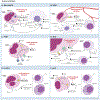Brain Tumor Microenvironment and Host State: Implications for Immunotherapy
- PMID: 30804019
- PMCID: PMC6635001
- DOI: 10.1158/1078-0432.CCR-18-1627
Brain Tumor Microenvironment and Host State: Implications for Immunotherapy
Abstract
Glioblastoma (GBM) is a highly lethal brain tumor with poor responses to immunotherapies that have been successful in more immunogenic cancers with less immunosuppressive tumor microenvironments (TME). The GBM TME is uniquely challenging to treat due to tumor cell-extrinsic components that are native to the brain, as well as tumor-intrinsic mechanisms that aid in immune evasion. Lowering the barrier of immunosuppression by targeting the genetically stable tumor stroma presents opportunities to treat the tumor in a way that circumvents the complications of targeting a constantly mutating tumor with tumor antigen-directed therapies. Tumor-associated monocytes, macrophages, and microglia are a stromal element of particular interest. Macrophages and monocytes compose the bulk of infiltrating immune cells and are considered to have protumor and immunosuppressive effects. Targeting these cells or other stromal elements is expected to convert what is considered the "cold" TME of GBM to a more "hot" TME phenotype. This conversion could increase the effectiveness of what have become conventional frontline immunotherapies in GBM-creating opportunities for better treatment through combination therapy.
©2019 American Association for Cancer Research.
Conflict of interest statement
Figures



References
-
- Sottoriva A, Spiteri I, Piccirillo SGM, Touloumis A, Collins VP, Marioni JC, et al. Intratumor heterogeneity in human glioblastoma reflects cancer evolutionary dynamics. Proceedings of the National Academy of Sciences of the United States of America 2013;110(10):4009–14 doi 10.1073/pnas.1219747110. - DOI - PMC - PubMed
Publication types
MeSH terms
Substances
Grants and funding
LinkOut - more resources
Full Text Sources
Medical

